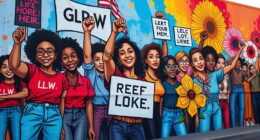Visual storytelling is a powerful way to boost environmental activism. Use striking images and videos to highlight issues like pollution, climate change, and deforestation, making complex problems simple and emotional. Share compelling narratives with strong visuals and ethical honesty to build trust and inspire action. Leverage social media, new technologies, and creative tools to craft memorable campaigns. Keep exploring to discover how these strategies can turn visuals into catalysts for real environmental change.
Key Takeaways
- Visuals like impactful images and videos effectively convey environmental issues, inspiring immediate action and emotional engagement.
- Ethical storytelling ensures honest, culturally sensitive visuals that foster trust and genuine understanding.
- Strategic use of color symbolism and narrative structures enhances emotional resonance and clarity of environmental messages.
- Photographic techniques capturing authentic emotions strengthen awareness and empathy around environmental challenges.
- Emerging technologies like AR, drones, and virtual exhibitions expand immersive storytelling and global outreach in activism.
The Power of Visuals in Environmental Campaigns
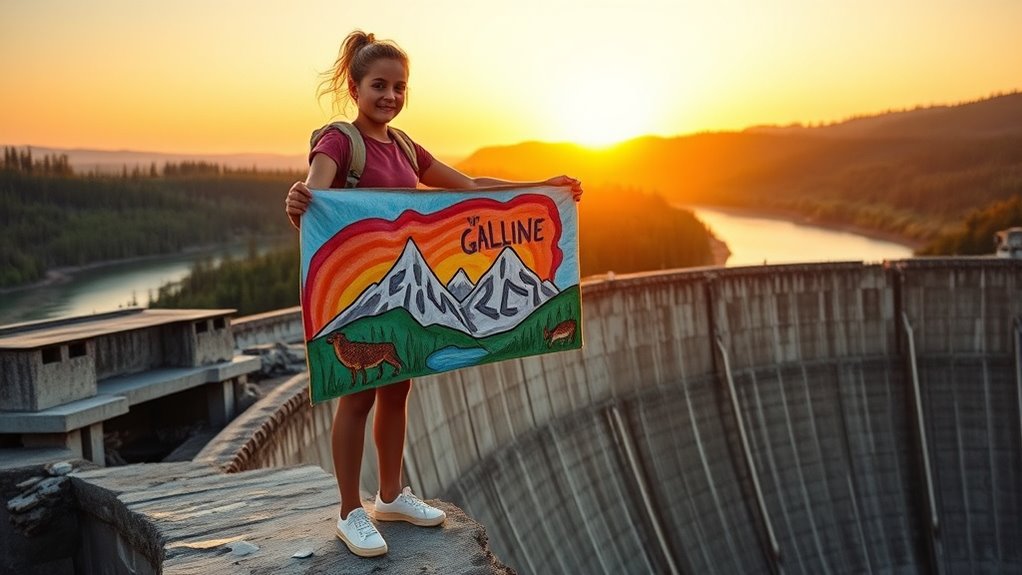
Have you ever wondered why a single powerful image can inspire action more effectively than words alone? It’s because visuals carry an aesthetic appeal that immediately captures attention and stirs emotions. When you see striking images of melting glaciers or vibrant coral reefs, their visual symbolism instantly conveys the urgency of environmental issues. These visuals simplify complex problems, making them more relatable and memorable for your audience. Strong imagery bypasses language barriers, allowing you to connect on a visceral level. By harnessing the power of compelling visuals, environmental campaigns can evoke empathy and motivate action faster than words alone. This emotional impact is essential for inspiring change and raising awareness, making visuals a crucial tool in environmental activism. Additionally, incorporating electric bikes and generators can demonstrate sustainable solutions in visual storytelling to further inspire eco-friendly behaviors.
Storytelling Techniques to Highlight Environmental Issues

Effective storytelling transforms compelling visuals into powerful narratives that resonate with audiences. To do this, you can leverage color symbolism to evoke emotions—green signifies growth, while gray suggests environmental degradation. Using clear narrative structures, such as problem-solution or cause-effect, guides viewers through complex issues seamlessly. Consider the following table to enhance your storytelling approach: | Technique | Purpose | Example | |—————————-|—————————————-|———————————| | Color Symbolism | Evokes emotional responses | Blue for water scarcity | | Narrative Structures | Creates clarity and flow | Problem-solution framework | | Visual Metaphors | Simplifies complex ideas | Cracked earth for drought | Incorporating visual storytelling techniques can also deepen audience engagement by illustrating interconnected environmental impacts.
Impactful Photography and Videography for Awareness
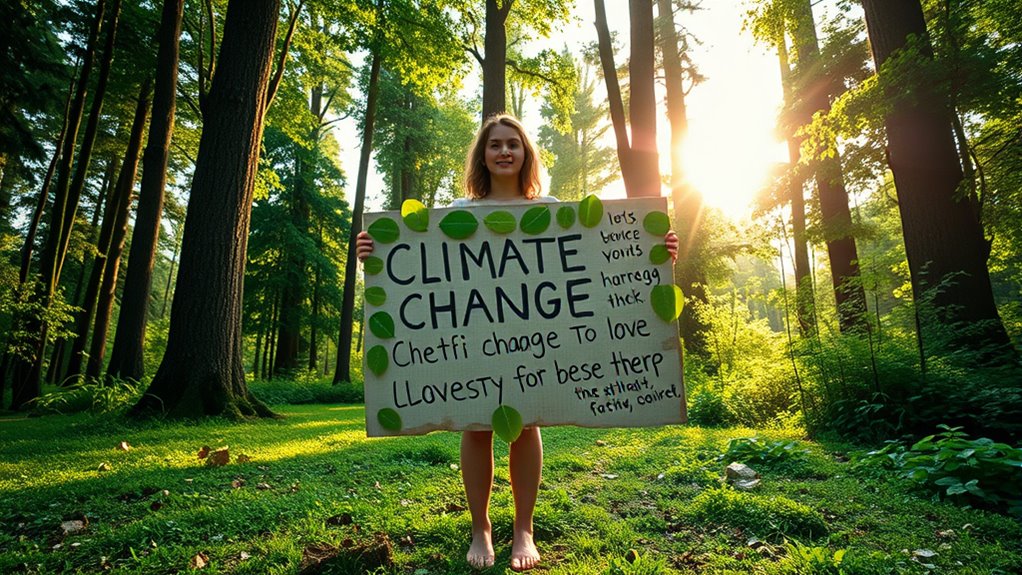
Impactful photography and videography capture emotional moments that resonate deeply with viewers, making environmental issues feel urgent and real. By highlighting key problems through compelling visuals, you can effectively raise awareness and foster understanding. When your visuals inspire action, they turn viewers into advocates for change. Additionally, emphasizing emotional connection in your storytelling helps deepen the viewer’s engagement and commitment to environmental causes.
Capturing Emotional Moments
Capturing emotional moments requires more than just pointing a camera; it demands an understanding of the story behind the image. When you focus on capturing emotional moments, you tap into the power of visual storytelling to evoke empathy and awareness. Your goal is to highlight genuine reactions and heartfelt expressions that resonate with viewers. Pay attention to details that reveal the human connection to environmental issues, such as tears, hope, or despair. Use lighting, angles, and timing deliberately to emphasize these feelings. Authenticity matters—let your audience see the raw emotion behind the scene. By thoughtfully capturing emotional moments, your images become more than documentation; they transform into compelling stories that inspire action and deepen understanding. Incorporating visual storytelling techniques can further enhance the emotional impact of your photographs and videos.
Highlighting Environmental Issues
Highlighting environmental issues through photography and videography transforms visuals into powerful tools for awareness. By capturing stark images of urban pollution, you reveal the impact of human activity on city environments, making invisible problems visible. Videos showing smog-filled skies or overflowing landfills evoke emotional responses, prompting viewers to reconsider their habits. Additionally, compelling footage of climate change effects—melting glaciers, rising sea levels—brings distant issues into focus, emphasizing urgency. Clear, impactful visuals can cut through data overload and political debates, making complex issues understandable at a glance. Your imagery can expose environmental injustices and highlight the need for change, inspiring others to recognize and address these pressing challenges with clarity and purpose. Incorporating color accuracy in visual storytelling enhances the realism and emotional impact of environmental imagery, making the issues more compelling and relatable to viewers.
Inspiring Action Through Visuals
When you share powerful images and videos that depict environmental issues, you can inspire immediate action. Effective visuals have strong aesthetic appeal, capturing viewers’ attention and evoking emotional responses. Use color symbolism intentionally—vibrant greens and blues can symbolize life and hope, while dull or dark hues highlight urgency or destruction. Your visuals should tell a story that resonates, making complex issues relatable and urgent. By emphasizing impactful photography and videography, you make environmental problems tangible, prompting viewers to contemplate their role and take action. Combining compelling imagery with strategic use of color creates a visual language that motivates change. Your visuals become not just informative, but also powerful catalysts for awareness and activism. Additionally, understanding the role of intelligence in environmental monitoring can enhance the credibility and reach of your visual storytelling.
Leveraging Social Media Platforms for Visual Narratives
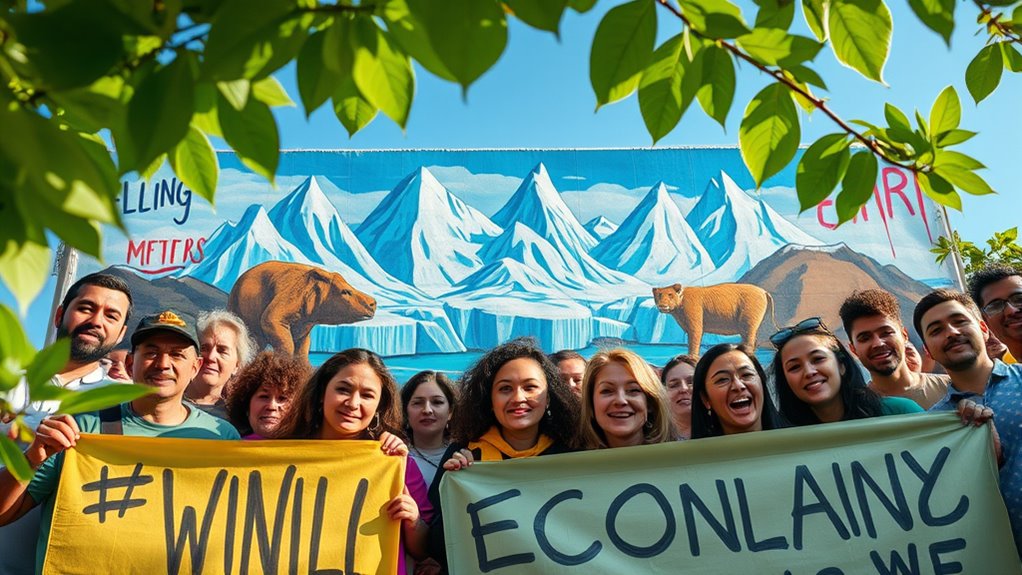
Social media platforms have become powerful tools for environmental activists to share compelling visual stories that reach wide audiences instantly. You can harness augmented reality to create immersive experiences, allowing viewers to interact with environmental data or visualize ecosystems firsthand. Interactive infographics make complex issues more accessible, engaging users directly and encouraging participation. By combining these tools with platforms like Instagram, TikTok, or Twitter, you amplify your message and foster a sense of immediacy. Visual storytelling through social media boosts awareness and motivates action, especially when content is tailored to resonate emotionally. Your ability to leverage these digital features increases engagement, spreads awareness rapidly, and inspires collective efforts toward environmental change. Additionally, incorporating Hyundai Tuning techniques can serve as a metaphor for customizing and optimizing how environmental messages are delivered, making your stories more impactful and memorable.
Case Studies of Successful Visual Environmental Activism

Many successful environmental campaigns have harnessed the power of visual storytelling to spark real change. Take urban conservation efforts that showcase before-and-after images of green spaces revitalized through community action, inspiring residents to participate. Climate activism has also benefited from impactful visuals, like powerful photographs of melting glaciers or extreme weather events that evoke urgency. One notable example is a campaign that used striking aerial shots of deforestation to raise awareness and mobilize policy change. These visuals make complex issues tangible and motivate action across diverse audiences. Additionally, the use of visual literacy helps audiences interpret and connect emotionally with environmental messages more effectively. By highlighting tangible results and emotional stories, these campaigns demonstrate how images can drive community engagement and influence public opinion. Your role is to learn from these case studies and craft visuals that inspire meaningful environmental progress.
Ethical Considerations in Environmental Visual Storytelling

As you craft environmental stories, you need to prioritize honesty and accuracy to build trust with your audience. Respect for your subjects is essential, ensuring you don’t exploit or misrepresent their experiences. Remember, your messaging should be powerful yet responsible, inspiring action without compromising ethical standards. Incorporating visual storytelling techniques can enhance engagement while maintaining integrity.
Authenticity and Accuracy
How can visual storytellers guarantee their images remain truthful while inspiring action? Prioritizing authenticity and accuracy is essential. You should always verify facts to confirm fact checking accuracy, preventing misinformation. Be mindful of cultural sensitivity—respect local customs and contexts to avoid misrepresentation. To maintain integrity, consider these key points:
- Cross-reference images with credible sources
- Avoid digital manipulation that alters the story
- Understand cultural nuances before sharing visuals
- Clearly label images to reflect context and origin
- Recognize the importance of emotional support in storytelling to foster genuine connections by understanding individual reactions and responses.
Respect for Subjects
Respect for subjects is fundamental to ethical environmental storytelling because your images can substantially impact the individuals and communities involved. Upholding image ethics means ensuring you portray subjects with honesty and sensitivity, avoiding manipulation or misrepresentation. Protecting subject dignity involves gaining consent and respecting their privacy, especially when sharing vulnerable or marginalized groups. You should prioritize their well-being over the story’s emotional pull, recognizing that images can influence perceptions and decisions about environmental issues. Always ask yourself whether your portrayal respects the subject’s humanity and rights. Ethical storytelling isn’t just about capturing striking visuals; it’s about honoring the trust and integrity of those you photograph. By doing so, you foster genuine understanding while avoiding exploitation or harm. Incorporating visual storytelling responsibly is crucial to maintaining the trust and respect of your subjects and audience alike.
Impactful Messaging
Ethical storytelling isn’t just about respecting your subjects; it also involves crafting messages that genuinely inspire action and awareness. To do this, you must carefully choose symbolic imagery that resonates emotionally and reinforces your message. Color psychology plays an essential role—using greens for growth and hope or reds to signal urgency and danger can amplify your impact. Be mindful of the stories you tell and how visuals can either empower or mislead viewers. Consider these key points:
- Use symbolic imagery that aligns with your message and avoids stereotypes
- Leverage color psychology to evoke specific emotions
- Make certain visuals inspire hope rather than despair
- Avoid sensationalism to maintain credibility and trust
- Incorporate Content Verification to ensure accuracy and prevent misinformation in your visual storytelling.
Tools and Resources for Creating Compelling Visual Content

Are you wondering which tools can elevate your environmental storytelling? Several resources can help you craft compelling visuals. Augmented reality (AR) apps allow you to overlay environmental data onto real-world scenes, making stories more immersive. Drone photography offers stunning aerial shots that reveal environmental changes from unique perspectives. To assist your creative process, here’s a handy comparison:
| Tool | Purpose |
|---|---|
| Augmented Reality Apps | Enhance storytelling with interactive visuals |
| Drone Photography | Capture high-quality aerial images of ecosystems |
| Photo Editing Software | Refine images and add impactful effects |
| Stock Footage Platforms | Access ready-made footage for quick storytelling |
Incorporating mechanical elements inspired by Steampunk and Victoriana designs can also add a distinctive, vintage touch to your visuals, engaging your audience even further.
Using these tools, you can create powerful, engaging visual content that resonates with your audience.
Future Trends in Visual Communication for Environmental Causes
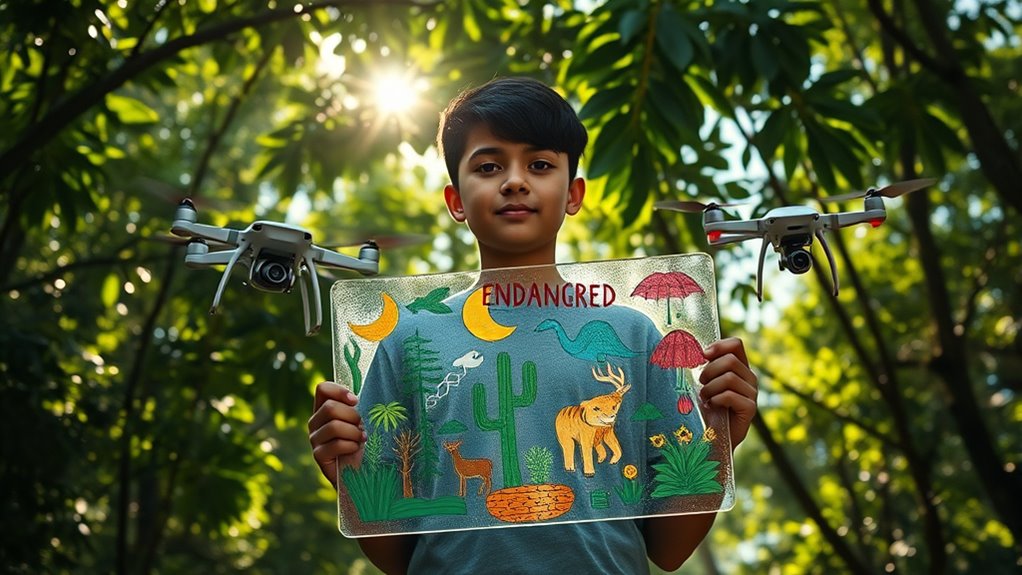
Advancements in visual communication technology are shaping the future of environmental activism, offering new ways to engage and inspire audiences. Augmented reality (AR) lets you bring immersive, interactive experiences directly to people’s devices, making environmental issues feel personal and immediate. Virtual exhibitions enable you to showcase stunning visual stories without geographical limits, reaching a global audience. Expect more integration of AR overlays in fieldwork, allowing activists to visualize data and impacts in real time. Virtual galleries will become more dynamic, featuring 3D environments and live interactions. You’ll also see increased use of 360-degree videos that transport viewers into natural habitats. As these tools evolve, incorporating visual storytelling techniques will be essential for creating compelling, accessible content that sparks action and deepens understanding of environmental challenges.
Frequently Asked Questions
How Can Visual Storytelling Influence Policy Changes on Environmental Issues?
Visual storytelling can profoundly influence policy impact by making environmental issues more relatable and urgent. You can use compelling images and narratives to sway public opinion, pressuring policymakers to act. Incorporate advocacy strategies like sharing stories on social media or at events to amplify your message. When your visuals resonate emotionally, they inspire policymakers to prioritize environmental change, turning awareness into concrete policy actions.
What Are Common Challenges Faced When Creating Environmental Visual Content?
Imagine you’re fighting climate change with your visuals, but resource limitations often hold you back, making it tough to produce impactful content. You might also face emotional fatigue from constantly witnessing environmental destruction and feeling powerless. Balancing quality with limited tools, time, and energy becomes a challenge. Still, persistence is key—your visuals can inspire change despite these obstacles, just as a vintage camera captures timeless stories amidst modern chaos.
How Do Cultural Differences Impact Environmental Storytelling Effectiveness Globally?
Cultural differences greatly impact your environmental storytelling by shaping how audiences interpret narratives. You need to understand local cultural narratives and storytelling traditions, as these influence emotional connections and message reception. When you adapt your visuals to reflect diverse cultural perspectives, you enhance engagement and effectiveness globally. Respecting and integrating local storytelling styles ensures your message resonates deeply, fostering greater awareness and action across different communities.
What Training or Skills Are Essential for Aspiring Environmental Visual Storytellers?
You need sharp photography techniques and storytelling frameworks to capture and convey urgent environmental issues. Master composition, lighting, and editing to make images pop, then weave compelling narratives that resonate emotionally. Practice sequencing your stories logically, like a good plot, so viewers stay engaged. A keen eye for detail and cultural sensitivity help guarantee your message hits home, inspiring action rather than just applause at your photo exhibit.
How Can Visual Content Address Misinformation and Skepticism About Environmental Issues?
You can address misinformation and skepticism by creating visual content that emphasizes infographic accuracy and emotional engagement. Guarantee your visuals are fact-based, clear, and backed by reliable data to build trust. Use compelling images and stories that resonate emotionally, making complex environmental issues relatable. By combining accuracy with emotional appeal, you help viewers see the importance of environmental action and dispel myths effectively.
Conclusion
By harnessing the power of visual storytelling, you can ignite a movement that shakes the very foundation of environmental indifference. Your photos and videos have the potential to awaken millions, transforming passive viewers into passionate activists overnight. Don’t underestimate the impact of your visuals—they could be the catalyst that saves our planet from devastation. Embrace this incredible tool, and watch your messages ripple across the world, sparking change on an unprecedented scale.









